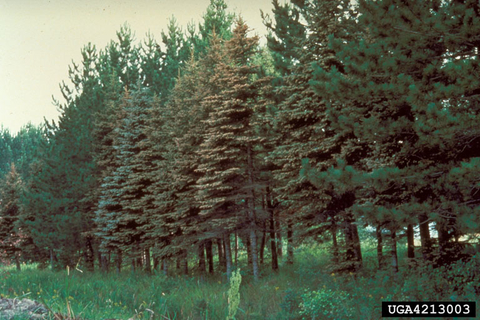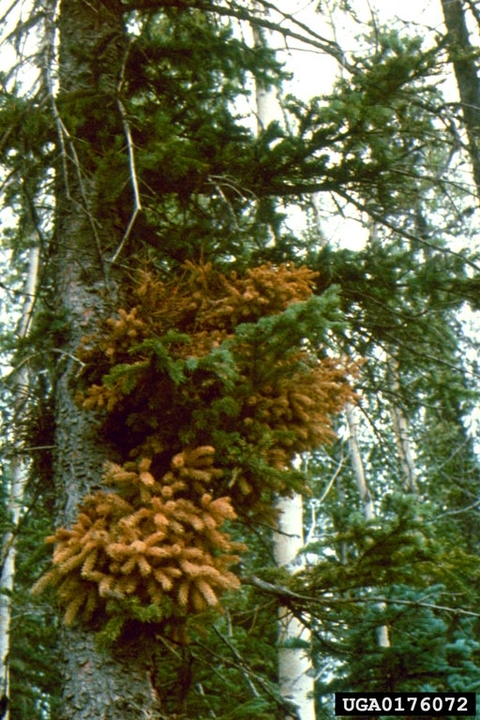Quick facts
- This disease is caused by fungi from several species of the genus Chrysomyxa.
- Young needles on infected trees turn yellow.
- Severely infected trees have a tan to pinkish look.
- Colorado blue, white and black spruce are most commonly affected by this disease.
- Needle rust is not a significant threat to the health of the tree and does not require management.
How to identify spruce needle rust
- Needles at the tips of the branches (current year needles) turn yellow.
- Pale orange to white, tube-like projections appear on infected needles in July or August and release powdery, orange spores.
- Severely infected trees may have a tan to pinkish look.
- Infected needles fall off in September.
- Some species of rust can cause witches' brooms. These are clumps of small weak branches arising from one point on a large branch.
Trees commonly affected by Spruce needle rust in Minnesota
Trees likely to be affected:
- Colorado blue spruce, Picea pungens.
- White spruce, P. glauca.
- Black spruce, P. mariana.
Trees not likely to be affected:
- Norway spruce, P. abies.
How does spruce needle rust survive and spread
Spruce needle rust is caused by fungi from several species of the genus Chrysomyxa.
- These rust fungi live half of their life cycle on spruce needles and the other half on an alternate host in the Ericaceae family.
- In Minnesota, labrador tea (Ledum groenlandicum), leather leaf (Chamaedaphne calyculata) and bearberry (Arctostaphylos uva-ursi) can all serve as alternate hosts for spruce needle rusts.
Spread of spruce needle rust through the seasons
- In the spring, spores are released from the alternate host plant. Young, growing spruce needles are infected if cool, wet weather is present.
- In the summer months, infected needles develop spore producing structures that release orange, powdery spores. These spores can only infect the alternate host plant and do not reinfect the spruce.
- At the end of the growing season, infected spruce needles often turn yellow and in most cases fall off.
- During winter, the fungus that causes witches' brooms and needle infection can overwinter in the infected spruce branches. All other spruce needle rust fungi overwinter in the alternate host plant.
How to manage spruce needle rust
In most cases spruce needle rust is a cosmetic problem and no management is needed. You can follow these best practices to help prevent and reduce damage spruce needle rust.
- Reduce moisture on needles by redirecting lawn sprinklers away from spruce trees.
- Space spruce trees to allow good air circulation around the tree.
- Prune out and destroy witches' brooms present in the tree.
- Remove all alternate host plants within 1000 feet of spruce trees. This will reduce disease on spruce but often isn’t possible or practical for trees planted near natural areas.
Reviewed in 2024




